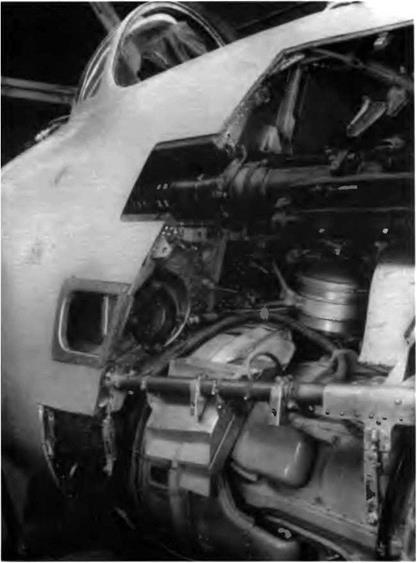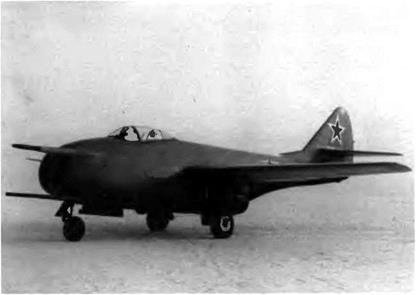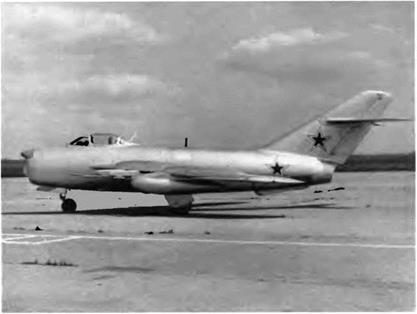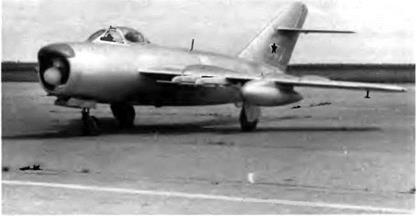Vladimir Yakovlyevich Klimov (1892-1962), member of the USSR Academy of Science, Hero of Socialist Labor, winner of the USSR State Prize, engineer major-general of aeronautical engineering
Klimov was educated in the automobile engine laboratory managed by the academician Ye. A. Chukadov. When the TsIAM was set up, he managed the gasoline engine department and was appointed professor. He lectured simultaneously at the Zhukovskiy military air academy. Then he went to France to negotiate the manufacturing license for the Hispano-Suiza twelve-cylinder V-type engine, which became in the USSR the M-100 rated at 750 ch. Derivatives of this engine —the VK-103, VK-105PF, and VK-107A—powered all of the Yakovlev fighters of World War II and the Petlyakov Pe-2 bomber. At the end of the war Klimov was developing the VK-108, but this engine never made it to production.
During one of the first postwar Paris air shows, Mikoyan and Klimov were able to examine the first Rolls-Royce centrifugal compressor jet engines. To pursue this technology, they went to Great Britain to order a small number of Nene turbojets. With these few engines, Klimov developed in the USSR the RD-45 for the MiG-15 fighter, the VK-1 for the MiG-17, and the reheated VK-1F for the MiG-17F. Later he designed the VK-5 and VK-7 experimental engines and developed the
VK-3, one of the very first turbofans, in close collaboration with one of his best assistants, Sergei Piotrovich Izotov.
Management of the Klimov OKB was entrusted to Izotov after its founder died in 1962. After graduating from the Leningrad polytechnic institute Izotov joined the OKB in 1941, where he became known over two decades for the turboshaft engines and reduction gears that he developed for the Mil and Kamov helicopters. But his first achievements included the GTD-350 turboshaft, the VR-2 reduction gear for the Mi-2, and the TV2-117 and VR-8 reduction gear for the Mi-8. Izotov worked hard at the same time on powering tanks with gas turbine engines, and he succeeded in developing the RD-33, a very reliable turbofan used for the MiG-29. Izotov died in 1983 and was succeeded by V. Stepanov and A. Sarkisov, who is today in charge of the design bureau.
Aleksandr Aleksandrovich Mikulin (1895-1985), member of the USSR Academy of Science, Hero of Socialist Labor, winner of the USSR State Prize, engineer major-general.
The first 100-percent Soviet engine, the AM-34 was developed under Mikulin’s supervision in the 1930s. The first MiG fighter was powered by a Mikulin engine, the AM-35. He went on the develop experimental high-altitude turbocharged engines such as the AM-39 and AM-42B. During World War II his AM-38 and AM-42 engines powered tens of thousands of П-2 and Il-l 0 shturmovik aircraft. After the war he developed the AM-3 turbojet for the first Soviet jet airliner, the Tu-104. His military turbojets powered mass-produced aircraft such as the MiG-19, MiG-21, and MiG-25, and he knew how to surround himself with talented assistants, namely, B. Stechkin, G. Livshits, S. Tuman – skiy, N. Metskvarshivili, V. Gavrilov, and K. Kachaturov.
Sergei Konstantinovich Tumanskiy (1901-73), member of the USSR Academy of Science, Hero of Socialist Labor, winner of the Lenin Prize and the USSR State Prize.
After graduating and soldiering at the Leningrad technical military school, the Zhukovskiy military air academy, and the TsIAM (central institute for airplane engine construction), Tumanskiy developed his first engine in 1938—the M-88, which powered the 11-4 bombers. In the early 1940s he joined the Mikulin OKB. In 1956 he was handed responsibility for developing the R-11F-300 twin-spool turbojet for the MiG-21 He kept the twin-spool layout for the R-11F2-300, rated at 6,000 daN (6,120 kg st), and the R-13-300, rated at 6,360 daN (6,490 kg st). Then he developed the R-27, rated at 7,645 daN (7,800 kg st), for the MiG-23 and the R-15B-300, rated at 10,000 daN (10,210 kg st), for the MiG-25
Pavel Aleksandrovich Solovyev (1917- ), chief constructor, corresponding member of the USSR Academy of Science, doctor of technical science, professor.
After graduating from the Rybinsk aeronautical institute, Solovyev joined the Shvetsov design bureau in 1939. Two years later he helped to launch the production of the ASh-82 radial engine and, later still, that of the ASh-82FN for the La-5 and La-7 fighters and that of the ASh – 82T for the 11-12 and 11-14 transport aircraft. The ASh-82 was selected in 1942 to power the DIS-200 (IT), and Solovyev personally supervised the installation of the engines on the MiG prototype. Then he worked with Shvetsov on the development of the most powerful piston engine of the time, the ASh-2K rated at 3,460 kW (4,700 ch)
Solovyev succeeded Shvetsov in 1953. The next year he began developing turbofan engines for airliners, the first of which was the D-
20 for the Tu-124. He worked simultaneously on the D-25V turboshaft engine and its R-7 gearbox for the Mi-6 and Mi-10 heavy helicopters. Pursuing his turbofan line of products, between 1964 and 1966 he designed the D-30, rated at 6,665 daN (6,800 kg st), for the Tu-134 airliner. It was the first Soviet engine to be certified worldwide Surprising as it may seem, the D-30 is still the core of tlje D-30F6 reheated turbofans, rated at 15,190 daN (15,500 kg st), that power the MiG-31 interceptor. Today the design bureau, located in Perm, works under the leadership of Yuri E. Reshetnikov on various versions of the PS-90 turbofan to power several types of airliners.
|
Engine
designation
|
No. of cylinders
|
Cylinder
arrangement
|
Pressure
ratio
|
Takeoff power
|
Specific fuel consumption
|
Dry weight
|
Takeoff
rating
|
Length
|
Width
|
Height
|
Diameter
|
|
|
|
|
ch (kW)
|
g/ch. h
|
kg (lb)
|
rpm
|
mm (in)
|
mm (in)
|
mm (in)
|
mm (in)
|
|
AM-35A
|
12
|
V60′
|
7.0
|
1,350 (993)
|
330-360
|
830 (1,829)
|
–
|
2,402 (94.57)
|
866 (34.09)
|
1,089 (42.87)
|
–
|
|
AM-38
|
12
|
V60‘
|
6.8
|
1,600 (1,177)
|
305-335
|
860 (1,895)
|
2,150
|
2.289 (90.12)
|
875 (34.45)
|
1,082 (42.60)
|
–
|
|
AM-38F
|
12
|
V60
|
60
|
1,700 (1,250)
|
305-325
|
880 (1,940)
|
2 350
|
2,287 (90.04)
|
878 (34.57)
|
1,084 (42.68)
|
–
|
|
AM-39B
|
12
|
V60
|
60
|
1,750 (1,287)
|
330-335
|
1,040 (2,292)
|
2,350
|
2.415 (95.08)
|
890 (35.04)
|
1,142 (44.96)
|
–
|
|
AM-42
|
12
|
V60
|
55
|
2,000 (1,471)
|
330-345
|
1,012 (2,230)
|
2,500
|
2 290 (90.16)
|
875 (34.45)
|
1,153 (45.39)
|
–
|
|
VK-107A
|
12
|
V60’
|
6.75
|
1 650 (1,214)
|
280
|
769 (1,695)
|
3.200
|
2,166 (85.28)
|
867 (34.13)
|
962 (37.87)
|
–
|
|
M-T1FM
|
5
|
single row
|
–
|
110 (81)
|
255-280
|
172(379)
|
1.800
|
1,010 (39.76)
|
–
|
–
|
1,075 (42.32)
|
|
M-82
|
14
|
double row
|
7.0
|
1,700 (1,250)
|
305
|
850 (1,873)
|
2,400
|
2,005 (78.94)
|
–
|
–
|
1,260 (49,61)
|
|
ASh-82F
|
14
|
double row
|
7.0
|
1,850 (1,361)
|
325
|
938 (2,067)
|
2,500
|
1,986(78.19)
|
–
|
–
|
1,260 (49.61)
|
|
Source: MiG OKB and TsIAM.
|
|
Type’
|
Mass flow
|
Pressure
ratio
|
Bypass
ratio
|
Thrust with afterburner
|
Specific fuel consumption
|
Max dry thrust
|
|
|
|
kg/sec
|
|
|
kg st (daN)
|
kg/kg st. h
|
kg st (daN)
|
|
|
D-30F6
|
TF, AB, TS
|
–
|
21 5
|
0.50
|
15,500 (15,190)
|
1.9
|
9,500(9.310)
|
|
|
RD-33
|
TF, AB, TS
|
76,3
|
21.9
|
0 47
|
8,300 (8,134)
|
2.0
|
5,040 (4,940)
|
|
|
R-35-300
|
TJ, AB, TS
|
110
|
13
|
–
|
13,000 (12,740)
|
1.96
|
8,550 (8,380)
|
|
|
R29B-300
|
TJ, AB, TS
|
104
|
12 4
|
–
|
11,500 (11,270)
|
1.8
|
8,000 (7,840)
|
|
|
R-29-300
|
TJ, AB, TS
|
110
|
13
|
–
|
12,500(12,250)
|
2.0
|
8,300 (8,135)
|
|
|
R-27F2M-300
|
TJ, AB, TS
|
95
|
10.5
|
–
|
10,000 (9,800)
|
1.9
|
6,900 (6,760)
|
|
|
AL-21F 3
|
TJ AB, SS
|
104.5
|
14.75
|
–
|
11,500 (11,270)
|
1.82
|
8,000 (7,840)
|
|
|
R-25-300
|
TJ, AB, TS
|
67.9
|
9.55
|
–
|
7,100 (6,960)
|
2.25
|
4,100 (4,020)
|
|
|
R-13-300
|
|
|
|
|
|
|
|
|
|
(R-13F-300)
|
TJ, AB, TS
|
65.6
|
89
|
–
|
6,490 (6,360)
|
2.093
|
4,070 (3,990)
|
|
|
R-11F2S-300
|
TJ, AB, TS
|
65.2
|
8.9
|
–
|
6,175(6,050)
|
–
|
3,900 (3,820)d
|
|
|
R-11F2-300
|
TJ, AB, TS
|
65
|
8.72
|
–
|
6,120(6,000)
|
2.19
|
3,950 (3,870)
|
|
|
R-11F-300
|
TJ, AB, TS
|
63.7
|
–
|
–
|
5,740 (5,625)
|
2.18
|
3,880 (3,800)
|
|
|
R-21F-300
|
TJ, AB, TS
|
74
|
8.7
|
–
|
7,200 (7,055)
|
2.35
|
4,700 (4,605)
|
|
|
R-15B-300
|
TJ, AB, SS
|
144
|
4.75
|
–
|
10,210 (10,000)
|
2.7
|
7,500 (7,350)
|
|
|
RD-36-35
|
LJ, SS
|
40.4
|
4.4
|
–
|
–
|
–
|
2,350 (2,300)
|
|
|
RD-45F
|
TJ, SS
|
40.5
|
4
|
–
|
–
|
|
2,270 (2,225)
|
|
|
AM-9B
|
|
|
|
|
|
|
|
|
|
(RD-9B)
|
TJ, AB, SS
|
43.3
|
–
|
|
3,250 (3,185)
|
1.6
|
2,600 (2,550)
|
|
|
AM-5F
|
TJ, SS
|
37
|
6.1
|
–
|
2,700 (2,645)
|
1.8
|
2,150 (2.105)
|
|
|
AM-5
|
TJ, SS
|
37.5
|
5.8
|
–
|
–
|
–
|
2,000 (1,960)
|
|
|
TR-1
|
TJ, SS
|
31 5
|
3.16
|
–
|
–
|
–
|
1,350 (1,325)
|
|
|
AL-5
|
TJ, SS
|
95
|
4.5
|
–
|
–
|
–
|
5,030 (4,930)
|
|
|
VK-7
|
TJ, SS
|
–
|
6.3
|
–
|
6,270(6,145)
|
–
|
4,200(4,115)
|
|
|
VK-5F
|
TJ, AB, SS
|
–
|
–
|
–
|
3,850 (3,775)
|
1 9
|
3,000 (2,940)
|
|
|
VK.-3
|
TF, AB, SS
|
98.4
|
12.7
|
0.12
|
8,440 (8,270)
|
1.9
|
5,730(5.615)
|
|
|
VK-1F
|
TJ, AB, SS
|
–
|
–
|
–
|
3,380(3,310)
|
2.0
|
2,650 (2,595)
|
|
|
VK-1
|
TJ, SS
|
48
|
4.2
|
–
|
–
|
–
|
2,700 (2,645)
|
|
Notes:
“TJ = turbojet, Lj = lift jet, TF = turbofan, AB = afterburner, SS = single spool, TS = twin spool bEHM = electro-hydromechamcal, HE = hydroelectronic. HM = hydromechanical cFirst figure is low-pressure stage number, second is high-pressure stage number dWhen the SPS (flap blowing) system is in use, 3,330 daN (3,400 kg st)
|
Specific fuel consumption
|
Turbine inlet temperature
|
Compressor
type
|
Structure
Compressor
|
Turbine
|
Weight
|
Flow
control*1
|
|
kg/kg st. h
|
К
|
|
|
|
kg (lb)
|
|
|
0.73
|
1,660
|
axial
|
5+10
|
2 + 2
|
2,416 (5,324)
|
HE
|
|
0.77
|
1,540
|
axial
|
4 + 9C
|
1 + Iе
|
1 050(2,314)
|
HE
|
|
0 96
|
1,493
|
axial
|
5 + 6
|
l + 1
|
1 765 (3,890)
|
EHM
|
|
0.94
|
–
|
axial
|
5 + 6
|
1 + 1
|
–
|
EHM
|
|
0.95
|
1,423
|
axial
|
5 + 6
|
1 + 1
|
|
EHM
|
|
0.97
|
1,373
|
axial
|
5 + 6
|
1 + 1
|
1,650 (3,637)
|
EHM
|
|
0.9
|
1.400
|
axial
|
14
|
2
|
1,700(3,747)
|
EHM
|
|
0.96
|
1,330
|
axial
|
3 + 5
|
1 + 1
|
1,210(2,667)
|
EHM
|
|
0.931
|
1,233
|
axial
|
3 + 5
|
1 + 1
|
—
|
EHM
|
|
–
|
–
|
axial
|
3+5
|
1 + 1
|
–
|
EHM
|
|
0.94
|
1,211
|
axial
|
3 + 5
|
1 + 1
|
1,117(2,462)
|
EHM
|
|
094
|
1,173
|
axial
|
3 + 5
|
1 + 1
|
1,182(2,605)
|
EHM
|
|
1.01
|
1,233
|
axial
|
3 + 5
|
1 + 1
|
1.220 (2,689)
|
EHM
|
|
1.25
|
1,215
|
axial
|
5
|
1
|
2,625 (5,785)
|
HE
|
|
1.33
|
1,230
|
axial
|
6
|
1
|
176 (388)
|
HM
|
|
1.07
|
1,140
|
centrifugal
|
1
|
1
|
814 (1,794)
|
HM
|
|
0.93
|
–
|
axial
|
9
|
2
|
695 (1,532)
|
HM
|
|
0.99
|
–
|
axial
|
8
|
2
|
624 (1,375)
|
HM
|
|
0.93
|
|
axial
|
8
|
2
|
445 (981)
|
HM
|
|
1.315
|
1,050
|
axial
|
6
|
1
|
815(1,796)
|
HM
|
|
0.95
|
1,050
|
axial
|
7
|
l
|
1,848(4,073)
|
HM
|
|
0.95
|
–
|
centrifugal
|
–
|
–
|
1,135(2,502)
|
HM
|
|
1.1
|
–
|
centrifugal
|
1
|
1
|
980(2,160)
|
HM
|
|
0.82
|
1,190
|
axial
|
2 + 8
|
3
|
1,850(4,077)
|
HM
|
|
1.15
|
–
|
centrifugal
|
1
|
1
|
978(2,155)
|
HM
|
|
1.07
|
1,170
|
centrifugal
|
1
|
1
|
870(1,917)
|
HM
|
APPENDIX 3.
Machine Guns and Cannons on MiG Fighters
|
Caliber
|
Weight
|
Rate of fire
|
Initial
speed
|
Weight of ammo
|
|
mm
|
kg (lb)
|
rpm
|
m/sec
|
g
|
|
ShKAS
|
7 62
|
10 (22)
|
1,800
|
825
|
96
|
|
BS (UBS)’
|
12.7
|
24 6(54 2)
|
800
|
860
|
48
|
|
BK (I JBK)"
|
12.7
|
21 5 (47.3)
|
1,000
|
860
|
48
|
|
N-57
|
57
|
135 (297.3)
|
230
|
600
|
2,000
|
|
N-37
|
37
|
103 (226.9)
|
400
|
690
|
735
|
|
NS-23
|
23
|
37 (81 5)
|
550
|
690
|
200
|
|
NR-23
|
23
|
39 (85.9)
|
850
|
690
|
200
|
|
NR-30
|
30
|
66 (145.4)
|
900
|
780
|
410
|
|
GSh-23I.‘
|
23
|
51 (112.3)
|
3,200
|
700
|
200
|
|
GSh-6-30d
|
30
|
145(319.4)
|
5 400
|
850
|
380
|
|
GSh-6-23d
|
23
|
–
|
8,000
|
700
|
200
|
|
GSh-301 (9A4071K)
|
30
|
46 (101 3)
|
1,800
|
860
|
380
|
|
Source MiG OKB.
Notes:
“Synchronized machine gun. hWing machine gun (nonsynchronized). ‘ 7 ‘win-barrel cannon.
‘‘Six-barrel cannon.
|
|
APPENDIX 4.
Some of the Radars Installed on MiG Fighters
|
|
Designation
|
Code
|
Manufacturer
|
Aircraft
|
Azimuth
|
Scanning
Elevation
|
RCS 16 m2
|
|
Izumrud
|
RP-1
|
Tikhomirov
|
MiG-17P,
|
target
|
|
12 km (7.45 mi)
|
|
|
|
MiG-19P
|
coordinates
|
|
|
|
TsD-30
|
RP-21
|
Nyenartovich
|
MiG-2 IP
|
±30"
|
–
|
20 km (12.43 mi)
|
|
Sapfir-21, S-21
|
RP-22
|
Volkov
|
MiG-2 IP
|
±30"
|
20"
|
30 km (18.64 mi)
|
|
Sapfir-23, S-23
|
–
|
Kunyavskiy
|
MiG-23P
|
±30′
|
6"
|
70 km (43.50 mi)
|
|
Smerch-A
|
|
Volkov
|
MiG-25P
|
+ 60
|
6"
|
100 km (62.15 mi)
|
|
Sapfir-25
|
RP-25
|
Kirpichev
|
MiG-25PD
|
±56
|
6"
|
100 km (62.15 mi)
|
|
Zaslon
|
S-800
|
–
|
MiG-31
|
±70
|
+ 70V-60"
|
200 km (124.30 mi)
|
|
Aircraft
|
No. of weapons x rounds
|
Year certified
|
|
MiG-1, MiG-3
|
2×600
|
1932
|
|
MiG-1 MiG-3
|
1 x 300
|
1939
|
|
MiG-3
|
2×145
|
1940
|
|
MiG-9
|
1 X40
|
1946
|
|
MiG-9
|
1 x40
|
1947
|
|
MiG-9
|
2×80
|
1944
|
|
MiG-15 (until 1950)
|
2×60
|
|
|
MiG-15 (from 1950), MiG-15 bis, MiG-17
|
2×60
|
1949
|
|
MiG-19
|
3 or 2 x 65
|
1955
|
|
MiG-21
|
2 or 1 x 60
|
|
|
MiG-21
|
1 x 200
|
1965
|
|
MiG-23
|
1 x 200/250
|
|
|
MiG-27
|
1 x 265
|
1974
|
|
MiG-31
|
1 x260
|
–
|
|
MiG-29
|
1 x 150
|
1980
|
|
Tracking
|
Systems
|
Fire sequencing display
|
Remarks
|
|
2 km (1.24 mi)
|
two antennae: scanning and tracking
|
no
|
–
|
|
10 km (6.21 mi)
|
single dish antenna
|
yes
|
TsD-30 experimental, RP-21 production
|
|
15 km (9 32 mi)
|
single dish antenna
|
yes
|
S-21 experimental, RP-22 production
|
|
55 km (34.1S mi)
|
single dish antenna
|
yes
|
Doppler detection despite ground clutter
|
|
50 km (31 07 mi)
|
single dish antenna
|
yes
|
detection at low altitudes
|
|
75 km (46.61 mi)
|
single dish antenna
|
yes
|
Doppler detection despite ground clutter
|
|
120 km (74.58 mi)
|
phased-array antenna
|
yes
|
look-down/shoot-down capabilities
|
[1]A single-engine fighter program that led to development of the Yak 15 and La-150 was launched at the same time as the twin-engine effort that produced the MiG-9 and Su-9.
[2]For various reasons, the designation MiG-23 was granted to other aircraft; but its final holder was the 23-11, a mass-produced VG fighter.
This was the first MiG-21 armed with air-to-air missiles, the first to be mass-produced, the first to be exported, and the first to be built outside the USSR (in Czechoslovakia, in India, and in China). It may be regarded as the basic model of the entire family. That is why we will devote special attention to this machine. But first it must be stated that the MiG-21F-13 did not come into its final silhouette until aircraft no. 115 left the assembly line. Starting with this aircraft, the fin height was reduced and its chord was increased. The following details refer to the final model, except where otherwise noted.
The MiG-21F-13 delta wing, like that of its predecessors, had a 57- degree sweepback at the leading edge and a 2.2 aspect ratio The wing airfoil was a TsAGI S-12 with a thickness ratio of 4.2 percent at the wing root and 5 percent at the wing tip; incidence, 0 degrees; anhedral,
[4] degrees; maximum chord, 5.97 m (19 feet, 7 inches); mean aerodynamic chord (MAC), 4.002 m (13 feet, 1.6 inches). The small fence that can be seen in front of each aileron had a height equal to 7 percent of the MAC. The trailing edge of each wing was fully occupied by a single – slotted flap of 0.935 m2 (10.1 square feet) and an inset aileron of 0.51 m2 (5.5 square feet). The flaps were hydraulically controlled, and the ailerons were hydraulically boosted by two BU-45 servo-control units. The wing structure was organized around three spars:
1. A front spar preceded by twenty-five ribs that were square to the leading edge, and a front false spar; the front wet wing tank was located ahead of that spar, close to the wing root
2. A center beam that was square to the fuselage datum line; the wheel was stored between the front spar and the center beam,
[5] Time to climb to 6,000 m (19,680 feet), 1 minute, 0 1 seconds
[6] Time to climb to 3,000 m (9,840 feet), 41 2 seconds
3. Time to climb to 9,000 m (29,520 feet), 1 minute, 21 seconds
[8] Time to climb to 12,000 m (39,360 feet), 1 minute, 59 3 seconds
The last refinement of the two-seat version, the MiG-21UM differed from its predecessor chiefly in its upgraded instrumentation. The KAP-
[10] autopilot was replaced by the three-axis AP-155 (the MiG-21R and all subsequent versions of the aircraft were fitted with the AP-155). The aircraft was also equipped with the ASP-PDF computerized optical fire control. The forward equipment bay received a plug-in rack to reduce maintenance downtime. The MiG-21UM was also powered by the R – 11F2S-300, rated at 6,050 daN (6,175 kg st). The total capacity of the fuel tanks was 2,450 1 (647 US gallons).
The MiG-21 UM succeeded the US on the assembly line in the Tbilisi factory in 1971 (for the VVS and export).
The MiG-211 was the test bed for the wing of the Tupolev Tu-144 supersonic airliner, allowing engineers to work out its airflow characteristics and test the whole flight control system. For the latter the
ОКБ engineers had to start from scratch since this was their first pure delta-wing aircraft.
[11]A few months after entering service, the MiG-25R was seen in Egypt Four aircraft of that type were delivered to Cairo by Antonov An-22 heavy cargo aircraft. The first reconnaissance missions over Israel set out from that airport in October 1971; the pilots and the field support crew were Soviets The aircraft flew in pairs, their missions covering the Israeli coast and the Sinai Peninsula, at speeds above Mach 2 35 and altitudes above 20 000 m (65,000 feet). It was more a “loan” than a true export venture
As development of the MiG-25 continued, various spinoff projects were considered. One of the most interesting—and unexpected—of these was a business jet (to be more precise and respect the Soviet terminology, “administrative" jet) designed between 1963 and 1965 to carry six passengers or an equivalent cargo load.
Even though Aeroflot might have evinced some interest in this aircraft, it was from the outset the OKB’s project; but it was more than a stylistic effort, and the design was carried to an advanced stage. One of
During the flight tests of the family s basic aircraft, the MiG-25P and MiG-25R, the pilots reported that—because of the peculiar flight envelope of those machines, especially its speed and altitude components— it was imperative to build a separate two-seat trainer for each of the two central missions, interception and reconnaissance. That is how the MiG-25PU and RU project started. The first one was completed in 1968, the second in 1972.
Both versions were unarmed and had no combat capabilities. In the preliminary design the ОКБ emphasized the greatest possible commonality not only between the two aircraft but also between the trainers and the basic versions. The MiG-25PU differed from the MiG-25RU only by its cockpit firing simulator. Unlike in the MiG-23 two-seater, the instructor was seated in the front cockpit. All control systems as well as a number of other systems (static and dynamic pressure indica-
















